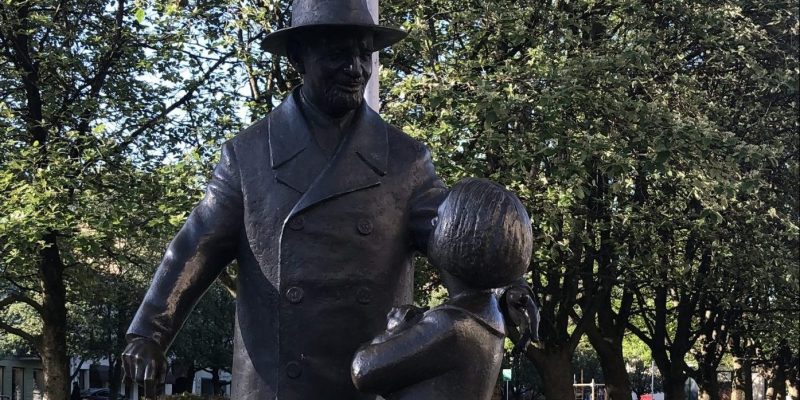WORTH VISITING:
The main street of the Jewish quarter in Vilnius – Jewish street – has been fiercely destroyed during the Second World War. However, some historical elements of this street remained intact after the war to remind us about the colorful past of the local Jewish community. And even those buildings, that had been destroyed, remained in many stories, myths and legends as a part of Jewish Vilnius narrative – about the Great Synagogue, about the genius of Vilna Gaon or even about one of the first public toilets in Vilnius. Stories of this street combine fragments from majestic achievements and brutality of daily life. A walk through Jewish Vilna without a walkthrough Jewish street would be incomplete.
BRIEF HISTORY:
When the Jewish community settled in Vilnius, this street soon became the central part of its quarter – all the ways led the Jewish community to this street until the beginning of the 20th century. At that time the so-called Pohulanka (nowadays – mostly J. Basanavičius str.) – new and modern center of Jewish life in Vilnius – took the spotlight from Jewish street. The Great synagogue and the great Vilna shulhof stood in Jewish street – all the members of the Jewish community came there to chat and spread the news. Almost every building on the Jewish street housed a separate prayer house for members of different professional communities. Neverthemore, this street became the spotlight of attention mostly because of Vilna Gaon, who lived in a small apartment of Jewish street in the 18th century, and it is where most of his worldly appreciated work on Jewish religious thought has been born. At the beginning of the 20th century yet another place became the centre of attention on the Jewish street – the majestic Judaica library of M. Strašūnas.
Despite the fact, that this street was the centre of the Jewish religious life in Vilnius, it was densely inhabited by mostly poor Jewish families. Tenants of this street were constantly changing and in the 19th century there lived not only Jewish families, but many newcomers, who came to Vilnius to find their luck – Poles, Russians etc. Until 1940 there were many small shops on the ground floors of the buildings on the Jewish street. The traders on this street operated not only in the buildings but outside on the street as well.
During the interwar period in Vilnius, there were several popular entertainment places of the long Jewish street as well. The most popular was the restaurant of U. Welfke, which was famous for its free bohemian atmosphere and visited by Vilnius artists of any ethnicity. Also, on this street was one of not so many vegetarian restaurants in Vilnius – it was opened by young creative woman Fania Lewando, who came to Vilnius from Warsaw.
In 1940 all the buildings on Jewish street were nationalized by Soviet occupants. In 1941 when Nazis occupied Lithuania, in September they established a ghetto (so-called Small Ghetto) in the previous territory of Jewish quarter and Jewish street became a part of the ghetto as well. This Small Ghetto was closed after two months – most of its inhabitants were murdered in Ponary, and the minority of them were relocated to the Big Ghetto.
After the Second World War, during the second Soviet occupation of Lithuania, the buildings on the Jewish street were nationalized once again.
CURRENT SITUATION:
After Lithuania regained independence in 1990, the Jewish street step by step is regaining its identity too. First of all, the Jewish street was re-associated with the remembrance of Vilna Gaon – in 1997 next to the house no. 3 on Jewish street the memorial plague and artistic sculpture of Vilna Gaon (sculptor – Mindaugas Šnipas) have been unveiled. In later years, during the symbolic action, the name of the street both in Yiddish and Hebrew next to its Lithuanian name had been placed. One of the newest initiatives for remembrance of Jewish heritage in this street – artistic installations space “House of Gaon” and a painting of the wall of building no. 1 on Jewish street by an art project “Walls remember”.
LOOKING AROUND:
Historical Jewish quarter, 54.679532, 25.285090
Jewish street, 54.679532, 25.285090
The place of the Great Synagogue and shulhof (jid. shulhoyf) (Žydų g. 3), 54.679901, 25.284511
The mausoleum of Vilna Gaon and his family (Jewish cemetery, Sudervė road, 28), 54.712898, 25.234477
A sculpture to Vilna Gaon (Žydų g. 3), 54.680137, 25.285079
Choral synagogue Taharat ha–Kodesh (Pylimo g. 39), 54.676070, 25.281575
Užupis synagogue (Užupio g. 36), 54.681471, 25.298633
A sculpture of doctor Cemachas Šabadas (sculpt. Romualdas Kvintas), 54.677248, 25.284342
Pohulanka (dab. J. Basanavičiaus gatvė), 54.680145, 25.276134
A sculpture of young boy as Romain Gary (sculpt. Romualdas Kvintas) (J. Basanavičius g. 14a.), 54.680145, 25.276134
The place of YIVO institute and its memorial plague (Vivulskio g. 18), 54.678840, 25.265085;
The place of old Jewish cemetery in Šnipiškės (Olimpiečių g. 1a), 54.690243, 25.291117
Jewish cemetery in Užupis (Olandų g. 22), 54.688106, 25.307748
The printing house of widow Rom and Rom brothers (A. Strazdelio g. 3), 54.675534, 25.292128
The writings in Žemaitija street (Žemaitijos g. 9, 54.677785, 25.281711) and in Saint Steponas street (Šv. Stepono g. 5, 54.674636, 25.281765)


